Yachting Monthly
- Digital edition


Electric outboard motor: we test 13 options
- Theo Stocker
- July 25, 2023
An electric outboard motor is now a viable option for dinghy propulsion. Emrhys Barrell puts the latest outboards and trolling motors to the test
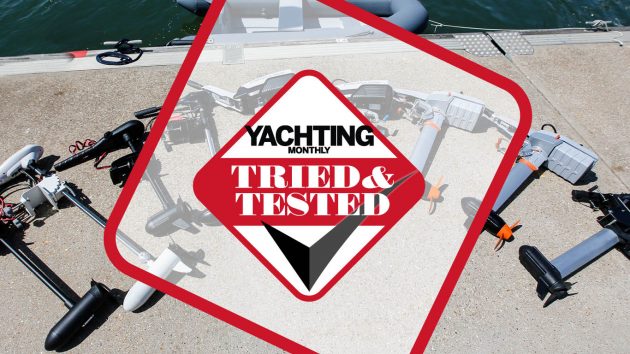
The electric outboard motor has been around for many years, but they have either been too low powered or their lead acid batteries have made them too heavy to lift in and out of a small tender, so petrol outboards have remained the engine of choice.
The development of lightweight lithium batteries has changed all this, making an electric outboard motor a practical alternative to petrol – and making all electric yachts a real possibility too.
With this in mind, we tested 12 models whose all-up weight, or the weight of their individual components, did not exceed the 14-17kg of a 2.5hp petrol outboard.
See how we tested the electric outboards at the end of this article.
Best electric outboard motor

Specifications Outboard weight: 12kg Overall weight with outboard and bracket: 14.5kg Battery capacity: 1085Wh Top speed: 5kts Thrust: 30kg / 66lbs
Designed along the lines of a dinghy rudder, this Remigo outboard is incredibly easy and intuitive to use. No external cables or anything to be snagged, it clips onto a bracket pre-mounted to your tender or dinghy, in a similar way that you’d attach a dinghy rudder.
Flip down the handle, attach the magnetic kill cord and you’re good to go.
On test this outboard gave as much thrust as the ePropulsion below but out performed it in terms of maneuverability. The Remigo can be switched from forward to reverse thrust at the touch of a button.
We like the Remigo for it’s sleek simplicity. If you want a clean smart easy to carry outboard to take you from your mooring to shore or quietly meander from your anchorage to shore then this is definitely worth considering.
We especially liked the rudder effect of this outboard giving us steerage even we had turn the power completely off to coast in alongside our pontoon.
Read Fox Morgan’s review of this outboard – Remigo One Electric Outboard review
Reasons to buy
very easy to stow, innovative rudder design, lightweight, built in battery, easy to mount and dismount
Reasons to avoid
No multiple battery swap options like more conventional electric outboards
Find a dealer at Silent Yachting

Photo: Paul Wyeth
ePropolsion Spirit 1.0 EVO
Yachting Monthly’s best buy
Specifications Motor weight: 10.5kg Battery weight: 9kg Battery capacity: 1276Wh Top speed RIB: 4.5mph Top speed skiff: 6.0mph Thrust: 31kg/68lbs
The Chinese firm ePropulsion has been developing its electric outboard motor range and lithium batteries for some time. We tested the Spirit 1.0 Plus and Evo, both 1kW motors with integral batteries.
Clearly ePropulsion was influenced by Torqeedo, but there are some important differences. From the outset ePropulsion went for a direct drive motor, being quieter and avoiding gearbox problems.
The battery has a greater capacity than the original Torqeedo, and is still 30% higher than the latest version. It also floats – useful if you should drop it overboard.
Fitting the battery is a two-handed job, with the carrying handle being at the back, and latch lock at the front, which requires leaning over the transom to install it. You also cannot see the locating slots underneath, which isn’t quite so easy in a bobbing inflatable. The power cable socket is protected by a rubber cap.
You have a display, but it only shows power being consumed, voltage, and remaining runtime, which means it has larger figures, easier to read on a sunny day, but it lacks GPS speed or range.
It has the same trim settings as the Torqeedo, with a similar fiddly retaining split ring. It also has a magnetic kill cord. Three shaft lengths are available, catering for transom heights up to 61cm. The shaft is streamlined but rotates through 360º for maximum manoeuvrability and reverse.
High battery capacity Quiet 360º rotation
Limited display options
Buy it now from epropulsion

Yachting Monthly’s best in class
Specifications Motor weight: 10.5kg Battery weight: 9kg Battery capacity: 1276Wh Top speed RIB: 4.5mph Top speed skiff: 6.0mph Thrust: 68lbs Regeneration: 4 knots – 40W / 10 knots – 300W
The 1.0 EVO has the same dimensions and performance as the Spirit, but it has the options of a removable tiller, plus remote controls and steering, but the real innovation is that it offers regenerative charging while you are sailing, putting 40W at 4 knots, and 300W at 10 knots back into the battery.
You can even have a wristband remote for steering and throttle.
The ePropulsion Spirit 1.0 EVO is undeniably more expensive than it’s little sister without the regenerative charging and the cost difference is significant. If you are likely to be doing a lot of sailing and using your electric motor from ship-to-shore in relatively remote locations then the regeneration will probably be worth it. For most, though the price differential is probably a little too steep.
Regenerative charging Removable tille Remote controls
Relatively expensive

Torqeedo 1103 and Torqeedo 603
Torqeedo 603 specifications Motor weight: 11kg Battery weight: 4.2kg (floats) Battery capacity: 500Wh Top speed RIB: 4.0 mph Top speed skiff: Not tested Thrust: 44lbs
Torqeedo 1103 specifications Motor weight: 11kg Battery weight: 6kg Battery capacity: 915Wh Top speed RIB: 4.4mph Top speed skiff: 6.0mph Thrust: 68lbs
Torqeedo was the first company to commercially produce an outboard with an integral lithium battery in 2005. The earliest motors used a high-revving geared motor, which produced a characteristic whine. Following the launch of its new larger battery, Torqeedo changed to direct drive at about the same time that ePropulsion arrived on the scene.
The 1103 is 1.1kW and has a removable battery and tiller/throttle. The battery locates in slots in the powerhead and can be dropped in one-handed, with the slots clearly visible from above, which is helpful in a rocking dinghy. It then hinges back and locks in place with a separate plastic pin. The tiller locates in similar slots.
The two are then connected to the motor by a power cable and a data cable, but the latter has an 8mm plug, with five tiny pins that have to be carefully lined up, then secured with a threaded plastic collar. Neither of the sockets have caps to prevent debris or water getting into them when the cables are not connected.
The display on the tiller shows four lines of data at the same time, which makes them small to read (a phone app can be used for a large display). They include volts, battery capacity, range at a given speed, speed in kts, mph or km/h, and power consumption in watts. A magnetic kill-cord cuts the power circuits if you fall overboard.
The motor has four trim positions to allow for angled transoms, but the split ring securing the locking pin is very stiff and fiddly, especially when you have to adjust it hanging over the transom. A side-mounted lever allows the motor to be tilted horizontally. In normal use a catch prevents the motor kicking up in reverse, but this can be released with another side-mounted lever if you are in shallow water.
Long and short shaft versions are available, with the height of the transom to the top of the prop on the long shaft being 62cm. Clamps screws and fittings are stainless steel, making it suitable for salt water use, but an anode is an extra. It has forward and reverse but not 360º rotation.
Established brand with relatively long history Removable battery and tiller Lots of display options
Display hard to read
Buy the Torqeedo 603 now from Torqeedo Buy the Torqeedo 1103 now from Torqeedo
Best Trolling motors
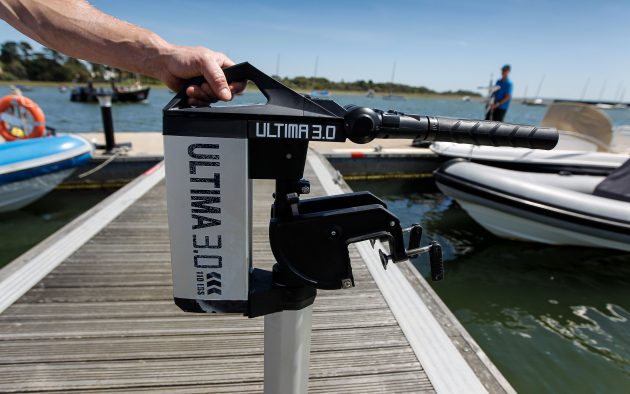
Haswing Ultima 3
Specifications Motor weight: 11kg Battery weight: 5kg Battery capacity: 600Wh Top speed: RIB 4.0mph Top speed skiff: Not tested Thrust: 51lbs
Haswing is a new name to us, but this Chinese manufacturer now has an extensive range of motors, several of which we were able to bring along to our test.
The Ultima 3 has an integral Lithium battery and an output of 1,000W, with the ‘3’ in its name indicating the 3hp petrol outboard its makers claim it is equivalent to. The battery is 600Wh.
The battery was the easiest of all in our test to fit and remove, just sliding down a set of grooves, with contacts in the bottom removing the need for any linking cables or wires, and an easy one-handed operation.
The unit is well engineered, with stainless steel used throughout plus an anode as standard, making this suitable for use in salt water, and a spare anode and shear pin. The tiller/throttle hinges up and down for easy operation and storage. It has a streamlined aluminium leg, but rotates 360º.
A magnetic kill cord is a useful safety feature, and there are 5 LEDs showing battery capacity remaining, but this is the only instrumentation, so there is no way of gauging how much power you are using. It also meant that with no exposed power cables, we could not measure intermediate power settings.
Easy to fit battery Anode as standard for salt water usage High end materials
Limited instrumentation
Buy it now from Amazon

Motorguide Varimax 40
Specifications Motor weight: 9.1kg Battery (Sterling 60Ah) – 8kg Battery capacity: 780Wh Top speed RIB: 3.2mph Top speed skiff: 4.0mph Thrust: 28lbs
Another trolling motor, this has a claimed 40lb thrust and a variable speed electronic control. The throttle pulls forward for ahead, and pushes back for reverse then twists in the same direction for speed. A clever feature once you get used to it. Ten LEDs show the battery state.
The sliding shaft gives transom heights up to 65cm transom to prop, and 360º rotation. It also quickly tilts through 90º, with 5 positions, for shallow or weedy water.
Clamp screws and fittings are mild steel, meaning you should wash it off with freshwater after using it in the sea.
Clever throttle control Variable transom heights accomodated
Quite basic in functionality

Haswing Osapian 55
Yachting Monthly’s best budget buy
Specifications Motor weight: 9kg Battery weight: (Sterling 60Ah) 8kg Battery capacity: 780Wh Top speed RIB: 3.3mph Top speed skiff: 4.4mph Thrust: 35lbs
This is another trolling motor with a claimed 55lb thrust, but with five forward speeds and three reverse on a twist-grip throttle. Again, it is a well-engineered motor, with all fittings and clamp screws made of stainless steel, an anode behind the prop and a spare in the box.
Five LEDs show the battery state. The sliding shaft gives transom heights up to 62cm, and 10 tilt positions.
As with all click-speed throttles you have double the power at Setting 5 compared to Setting 4, and very poor range figures at intermediate speeds compared to motors with electronic throttles.
However it is an excellent value-for- money option for sailors looking for ways to power their tender for short trip
Well engineered Value for money
Poor range at medium speeds

Motorguide SW82
Specifications Motor weight: 13kg Battery weight: 16kg Battery capacity: 1,560Wh Top speed RIB: 4.0mph Top speed skiff: 5.5mph
Motorguide is a well-established US company that is part of the Mercury/Mariner group. The most powerful of the transom mount range, the 82 has a claimed thrust of 82lbs, and is a 24V unit requiring two 12V batteries in series.
It is also designed for saltwater use, with stainless steel clamp screws and fittings, and a large anode on the shaft. It has an extra long shaft, giving up to 93cm transom height to the prop, 360º rotation, and seven tilt positions There are no battery LEDs. An on/off switch under the control head is the nearest it gets to a kill switch.
Well known company Powerful Anode for salt water
No battery LEDs

Haswing Protruar 1
Specifications Motor weight: 9kg Battery weight: 8kg Battery capacity: 780Wh Top speed RIB: 3.4mph Top speed skiff: 4.5mph Thrust: 40lbs
Another Haswing requiring a separate 12V battery, this has a variable speed electronic throttle, and similar features to the Protruar 5, except no kill cord. It claims to be equivalent to a 1hp petrol motor, but in practice delivered 600W.
The sliding shaft only allows transom heights up to 40cm, but a longer shaft version is available. It has 10 tilt positions and 360º rotation.
Another well engineered unit, with stainless steel used throughout plus an anode as standard, and a spare anode and shear pin. The tiller/throttle hinges up and down for easy operation and storage.
Anode for salt water use 360º rotation
No kill chord Limited transom height range
Haswing Protruar 5
Specifications Motor weight: 14kg Battery weight: 16kg Battery capacity: 1,560Wh Top speed RIB: Not tested Top speed skiff: 6.1mph Thrust: 108lbs
Another Haswing, the Protruar 5 is the most powerful model we tested. The unit is extremely well engineered, with stainless steel used throughout for the clamp screws and fittings, plus an anode as standard, making this suitable for use in salt water. A nice touch is the spare anode and shear pin in the kit. The tiller/throttle hinges up and down for easy operation and storage.
Its 5 designation indicates its makers think it is equivalent to a 5hp petrol motor, but in reality it delivers around 2.5kW at 24V so requires two separate batteries. It has a variable electronic throttle, three battery state LEDS and a magnetic kill cord.
The shaft slides up and down, giving a maximum transom height of 62cm and 360º rotation. Ten tilt positions are quickly engaged by a squeeze lever.
The thrust was the highest of the test, making it suitable for heavy boats, but the fine pitch prop significantly reduced its efficiency at speed.
Powerful model Anode for salt water use Battery LEDs and kill chord
Needs two batteries for full power

Motorguide R3 45
Specifications Motor weight: 9.5kg Battery weight: (Sterling 60Ah) 8kg Battery capacity: 780Wh Top speed RIB: not tested Top speed skiff: 4.1mph
This trolling motor has a claimed thrust of 45lbs and five forward speeds. The sliding shaft gives transom heights up to 65cm and 360º rotation, with seven tilt positions. Clamp screws and fittings are mild steel, so should be washed after saltwater use.
The click-speed throttle gives non-linear power gaps, with Speed Setting 5 being double the power of Setting 4. This throttle arrangement results in poor range figures at medium speeds compared to motors with electronic throttles, but it keeps the price down.
360º rotation Plenty of transom height range
Minn Kota Endura Max 55
Specifications Motor weight: 9.5kg Battery weight: (Sterling 60Ah) 8kg Battery capacity: 780Wh Top speed skiff: 4.6mph
Minn Kota is one of the oldest makers of trolling motors. The Max 55 has a claimed 55lb thrust, with a variable speed electronic twist-grip throttle.
Clamp screws and fittings are mild steel, making it best suited for freshwater, though you can use it in the sea if you wash it off afterwards.
It has a fine pitch prop like all trolling motors, which gives a good static thrust, but efficiency, and hence range, falls off at higher speeds, though the electronic Maximiser throttle helps to offset this.
Electronic maximiser throttle helps offset range issues
Big range drop off at high speeds Needs washing after salt water usage
Buy it now from MinnKota
How we tested the electric outboard motors
We took a selection of electric outboard motor units available on the market, and tested them in two situations, firstly on a Frib 275 folding RIB on the Lymington River to reproduce the situation of getting out to your boat in the tender. We then put them on a 4m skiff on the Thames, to see how they perform at higher speeds on a boat with a smoother underwater form and longer waterline on sheltered waters.
Speed: We measured speed using a handheld GPS, and electricity consumed using a clamp ammeter or the motor’s inbuilt power display. We converted these to the range you would achieve, either for a given power, or the full power of the motor’s battery.
Thrust: We measured static thrust using a spring balance. This is a somewhat crude test, as it measures the pulling power of a motor in a static boat, and therefore doesn’t allow the propeller pitch to work at its designed speed.
Function: We checked the stated weights of each of the motors and made a qualitative survey of their main features when used as a dinghy outboard.
We tested the trolling motors with a 60Ah lithium battery from Sterling Power, which cost £360, though you can use a heavier lead acid battery costing around £120 for a good quality AGM or gel. Don’t bother with leisure batteries, which will fail after 4 to 5 trips. You will need a good quality Lithium charger, which will add on £100 or more.
We haven’t included charging in this test, as this is dependent on the charger you are using, whether you are charging from 240V or 12V on board, and whether the power source is mains, a generator, alternator or solar. It’s worth noting that you will rarely be recharging from flat, and will rather be aiming to top up batteries after each use.
Trolling motor or electric outboard motor?
The options today are trolling motors with separate batteries – so called because they were mainly used as auxiliary slow-speed power for anglers, and integral-battery motors built for dinghy propulsion. These are the options a sailor will be looking at when thinking about changing to an electric outboard.
Trolling motors are still popular for low-speed applications, as they are simple and cheap, but they do need a separate 12V battery.
The integral battery motors are sophisticated units designed to give you more speed and greater range for a given power in a small boat, though for any 3-4m boat, the hull speed will limit how fast you can realistically go with any motor unless you start planing.
An electric outboard motor with an integral battery will often include displays showing speed, range at a given speed, and percentage of battery capacity remaining, but these features come with a higher price tag.
The trolling motors and integral battery models in our test were similar in weight and both come in at around the same total weight as a 2.5hp petrol engine.
Enjoyed reading this?
A subscription to Yachting Monthly magazine costs around 40% less than the cover price .
Print and digital editions are available through Magazines Direct – where you can also find the latest deals .
YM is packed with information to help you get the most from your time on the water.
- Take your seamanship to the next level with tips, advice and skills from our experts
- Impartial in-depth reviews of the latest yachts and equipment
- Cruising guides to help you reach those dream destinations
Follow us on Facebook , Twitter and Instagram.
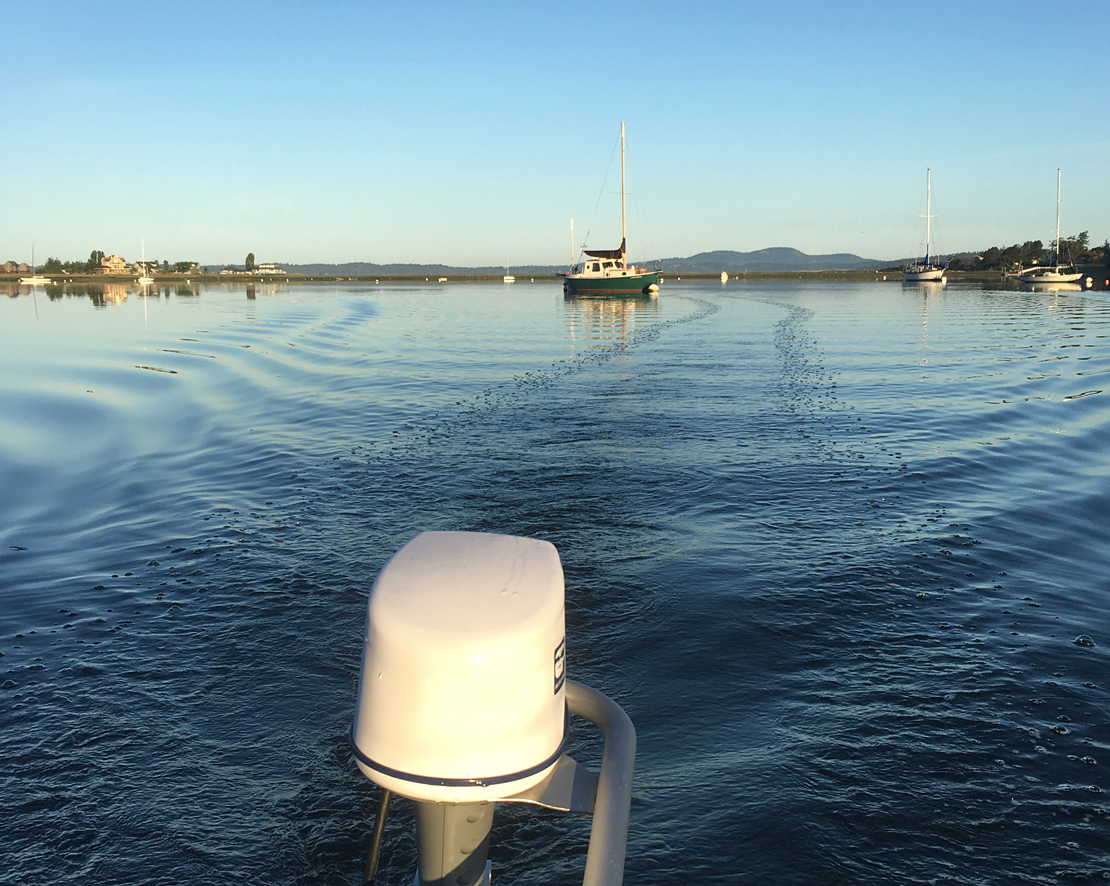
Award-winning ship-to-shore dinghy power
The US-made EP Carry is the only outboard designed and optimized specifically for small boats. Dinghies, small skiffs, small sailboats, canoes and fishing kayaks that have unique design needs and speed–drag characteristics. EP Carry's portability, reliability, longevity, power, and range satisfies these needs, and its lightweight simplicity gives everyone the ship-to-shore independence they crave. Other outboards are designed for larger boats and can’t match EP Carry's design features and ease-of-use benefits.
EP Carry System
Light & compact.
Get motoring in 4 easy steps
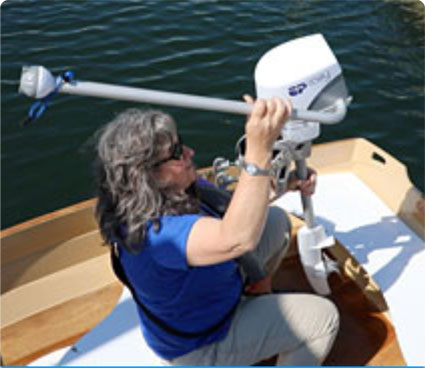
Quick set-up and pack-up
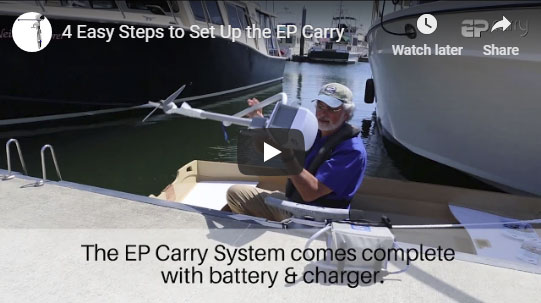
Easy beaching and launching
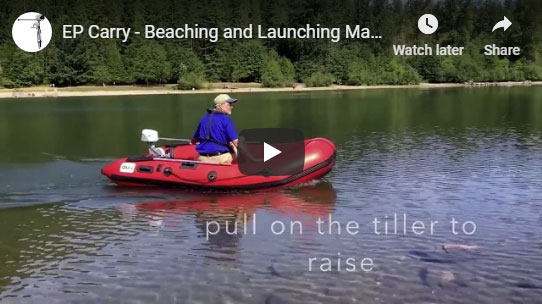
Is the EP Carry right for my boat?
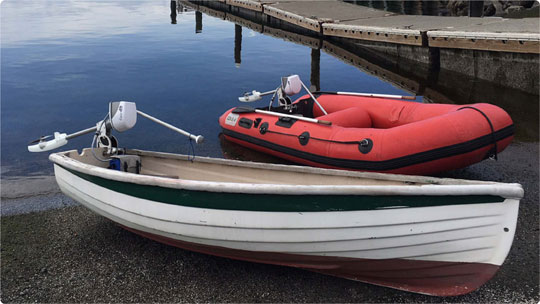

The Best Outboard Motor for a Sailboat

Last Updated by
Daniel Wade
June 15, 2022
The technology of sailing has remained mostly unchanged for centuries. Since learning to harness the power of wind, sailors have been transiting the world’s oceans, expanding trade routes and exploring new cultures. Although nothing more than a renewable natural resource and a single sail is needed to move a sailboat along the water, there are times when it’s important (and in our modern age, convenient) to leverage off a motor to get you where you need to go.
Like any unique piece of equipment in the world of sailing, outboard motors come in a variety of sizes with features and options to fit any owner’s needs. But of course, one size doesn’t fit all. Every boat is different – even those that come off the production line at the same time – and every owner is looking for something specific when it comes to their sailboat. From the purpose of owning the boat (blue water sailing vs. racing) to the location and impact on maintenance (cold weather vs. tropical weather), an outboard motor is just one of the many elements that will define a sailboat’s function and performance.
Whether you’re a new owner, or a veteran sailor, it’s important to know the basic components of any outboard motor . You should also have an idea of what you want your outboard motor to do for your size and model sailboat.
Table of contents
Outboard Motor Size
A larger boat doesn’t necessarily mean a larger motor. Although there are different ratings for different classes of boats, a small power plant can be more effective than a larger one. Conversely, an outboard motor can easily overpower a small boat and create unsafe conditions at high speeds. Guidelines and requirements differ between motorboats and sailboats. And while there is some overlap, these considerations apply directly to sailboats.
Engine power has to do with how much water a boat displaces. For sailboats, smaller is better. If you’re a bit of a math geek, the exact formula is 4 horsepower for every 2200lb of weight. Coupled with a propeller size, which can be determined using a propeller calculator , you’ll get a rough estimate to use as a guideline to start shopping. This is a good first step, since size is essentially a fixed variable. Though it’s worth noting for those who are buying a sailboat directly from the manufacturer, that actual weight will increase after delivery – once all other rigging and outfitting has been completed.
Physical size of your outboard motor is an important consideration and is directly related to the design of your sailboat. An outboard motor is made up of three parts from top to bottom:
- The Powerhead – Houses the engine. The bulbous part of the motor.
- The Midsection – Houses the exhaust system. Varies in length and design.
- The Lower Unit – Propellers attach to the gearbox. Submerged when operational.
Shaft length is an important design element and should be considered when purchasing a motor. A shaft that is too short will obviously prevent the propeller from being submerged in water, while a shaft that is too long will extend the propellers too far. Not only will it decrease the efficiency of your engine, it will create unnecessary drag. Know your transom length when looking at different models.
When an outboard motor is not being used, it should be stowed in its upright position. Some of the larger motors have an automated switch that will raise it out of the water, but some must be secured manually. Make sure everyone who sails with you is capable of lifting and securing the motor out of the water in case of an emergency.
Outboard Motor Power
Any kind of motor installed on a sailboat (inboard or outboard) should be viewed as a tool to help with maneuvering. Although there are some very skilled sailors out there who can sail into their slip without the aid of a motor, many harbors have restrictions that either don’t allow for the use of full sails, or there simply isn’t enough room to maneuver. A motor with both forward and reverse gears helps tremendously with docking.
While there is no exact correlation between boat length and total weight, the following is a rough guideline:
- 1-4 HP for boats up to 20’ (approximately 1000-2000lbs)
- 4-18 HP for boats between 20-30’ (approximately 2,000-10,000lbs)
- 18-34 HP for boats between 30-40’ (10,000lbs or more)
There are some things to consider when deciding how much horsepower you need or want. Location and the type of conditions you expect you’ll be sailing in is one of the biggest factors. Heavy seas and high winds typically associated with open ocean sailing will put more strain on your engine, and in some cases overpower it, whereas an engine that is heavier than needed will add unnecessary weight when racing. If you plan on motoring for long distances, consider purchasing an engine that will stand up to a lot of use.
Less HP is required for:
- Boat Design – Single hull boats made out of fiberglass require less power.
- 2-Stroke Engines – This is due to an overall lighter weight engine and higher torque.
- Diesel Engines – Diesel delivers more torque because the rate of compression is greater.
- Bigger Propellers – More surface area means more water displacement.
- Location – Motoring on lakes and rivers requires less power than open ocean.
- Distance – A smaller engine is suitable for shorter distances.
More HP is required for:
- Boat Design – Catamarans and heavier boats (regardless of size) require more power.
- 4-Stroke Engine – Engine weight and an extra step of compression yields less power.
- Gas Engines – The rate of compression for gas engines is much lower than diesel.
- Smaller Propeller – A smaller propeller displaces less water.
- Location – Open ocean, with tides and currents, will strain a smaller engine.
- Distance – Cover more distance when wind conditions are poor requires a larger engine.
Outboard Motor Cost
There is no way to quantify how much you will pay for any given motor. But there are several costs associated with owning an outboard motor that are definitely worth considering when making your purchase.
Certainly, a lager, more-powerful engine is going to be costlier than a smaller engine with lower horsepower. But as mentioned earlier, size is not necessarily a guarantee of performance and efficiency. At the same time, there’s only so much you can get out of an engine before you exceed its capability. Larger engines tend to help with resale value should you choose to sell your boat at some point, but a boat outfitted with right motor to begin with will always perform better than a motor that’s large just for the sake of it.
Factor in maintenance costs and fuel when looking at models. You want to run your engine at around 90% of its max RPMs to balance proper fuel usage and with wear and tear. Making a few calls to marine mechanics to inquire about an engine you’re interested in will give you a lot of information a sales person won’t be able to give you. The good news about outboard motors is that most of them are portable, which means you won’t have the added cost of either paying a mechanic to come to you, or having to get your boat to the yard, which usually requires help from a very good friend willing to spend all day driving and sailing back and forth.
Owning a boat requires constant care and maintenance, so a little knowledge goes a long way. While an outboard motor is not required for sailing, it’s a convenient addition that can greatly increase your enjoyment out on the water. Being patient and spending time researching engines will not only help you make the correct purchase but will help you take advantage of a great deal when it presents itself. Whether you sail the Caribbean, or race off the coast of California in a catamaran, there is an outboard motor that’s just right for you.
Related Articles
I've personally had thousands of questions about sailing and sailboats over the years. As I learn and experience sailing, and the community, I share the answers that work and make sense to me, here on Life of Sailing.
by this author
Sailboat Upgrades
Most Recent

What Does "Sailing By The Lee" Mean?
October 3, 2023

The Best Sailing Schools And Programs: Reviews & Ratings
September 26, 2023
Important Legal Info
Lifeofsailing.com is a participant in the Amazon Services LLC Associates Program, an affiliate advertising program designed to provide a means for sites to earn advertising fees by advertising and linking to Amazon. This site also participates in other affiliate programs and is compensated for referring traffic and business to these companies.
Similar Posts

How To Choose The Right Sailing Instructor
August 16, 2023

Cost To Sail Around The World
May 16, 2023

Small Sailboat Sizes: A Complete Guide
October 30, 2022
Popular Posts

Best Liveaboard Catamaran Sailboats
December 28, 2023

Can a Novice Sail Around the World?
Elizabeth O'Malley

4 Best Electric Outboard Motors

How Long Did It Take The Vikings To Sail To England?

10 Best Sailboat Brands (And Why)
December 20, 2023

7 Best Places To Liveaboard A Sailboat
Get the best sailing content.
Top Rated Posts
Lifeofsailing.com is a participant in the Amazon Services LLC Associates Program, an affiliate advertising program designed to provide a means for sites to earn advertising fees by advertising and linking to Amazon. This site also participates in other affiliate programs and is compensated for referring traffic and business to these companies. (866) 342-SAIL
© 2024 Life of Sailing Email: [email protected] Address: 11816 Inwood Rd #3024 Dallas, TX 75244 Disclaimer Privacy Policy

Home » Blog » Gear » Buyers guide to electric boat motors (2023)
Buyers guide to electric boat motors (2023)
By Author Fiona McGlynn
Posted on Last updated: August 3, 2023
Considering making the switch to an electric boat motor? With electric vehicles now commonplace on the roads, it’s no wonder so many boaters are curious about electric boats.
While electric boat motors have been around for a while, in the last several years the technology has taken huge leaps, resulting in more powerful motors, longer-lasting batteries, and ultimately more options for recreational boat owners.
Today, many types of boats can be outfitted with an electric propulsion system including pontoon boats, sailboats, jon boats, powerboats, fishing boats, yachts, and trawlers . If your boat’s combustion engine is in the range of 1 to 135 hp (.75 to 100 kW), you should be able to find an electric substitute.
While electric boating hasn’t gone mainstream—it’s estimated that close to 2% of recreational boats are electric—it’s still a great time to be thinking about making the switch, particularly if you own a tender, sailboat, or boat on a green lake where combustion engines are prohibited.
Table of contents
- 1.1 Benefits
- 1.2 Drawbacks
- 2.1.1 Key features of electric outboard boat motors
- 2.1.2 Electric outboard manufacturers
- 2.2.1 DIY electric inboard boat motor conversion
- 2.2.2 Key features of electric inboard boat motors
- 2.2.3 Electric inboard manufacturers
- 2.3.1 Serial vs. parallel hybrids
- 2.3.2 Key features of marine hybrids
- 2.3.3 Marine hybrid manufacturers
- 2.4.1 Electric pod and sail drive manufacturers
- 3 Batteries
- 4 Ready to catch the electric boating wave?
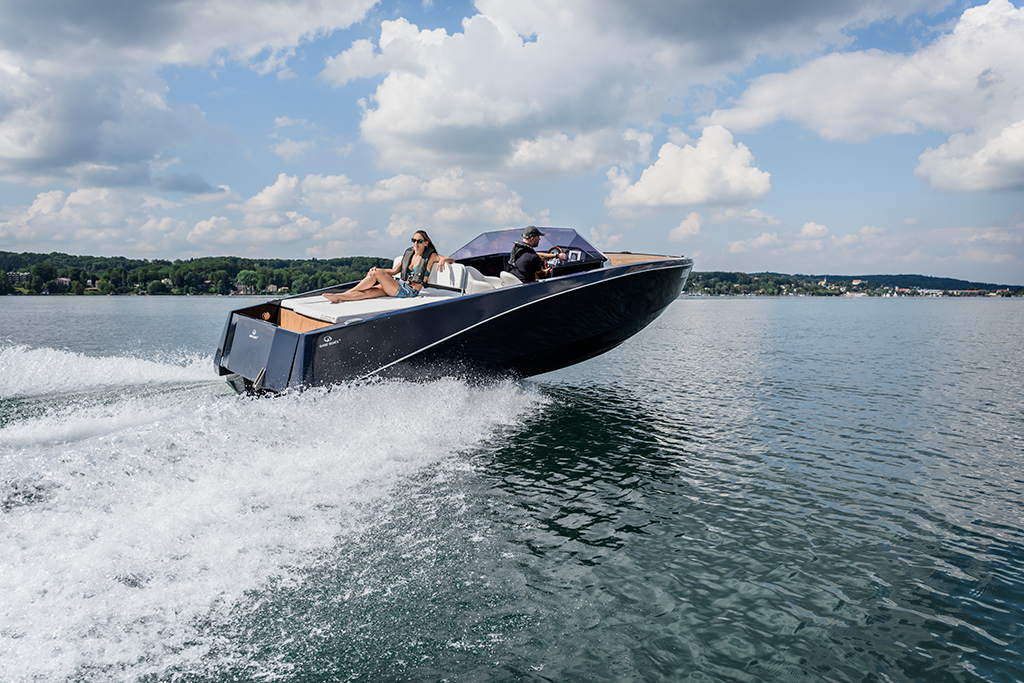
Benefits and drawbacks of electric boat motors
Electric marine motors offer several advantages over internal combustion engines:
- They’re completely silent .
- No noxious fumes or smelly exhaust gases to deal with.
- Instant torque. Electric propulsion provides instant torque, giving you better maneuverability and more consistent speeds in choppy conditions.
- Lightweight. An electric setup (including motor, batteries, and generator) typically weighs less than its diesel counterpart.
- No fuel cost. Charging an electric boat may cost a couple of dollars per charge.
- Easy to maintain. Imagine the maintenance on an outboard with no gas, spark plugs, or oil! Electric motors are simple, more reliable, and virtually maintenance-free.
- Renewable power. Once you’ve gone electric you can get power from renewable sources like wind generators and solar panels.
- Better for the planet. Electric marine motors don’t produce water pollution or produce harmful emissions like carbon dioxide (CO2), nitrogen oxides (NOx), and hydrocarbon (HC).
- Range. The greatest drawback of electric boats is their limited range, which is often measured in the 10s of miles. Range is limited because batteries don’t have the same energy density as fuel — they can’t provide the same energy, pound-for-pound as a tank of gas. A good battery monitoring system, one that displays the remaining range in real-time, can help boaters manage energy consumption and ease range anxiety. For those who want to go farther afield, hybrid propulsion may be a better option.
- Upfront cost. This new technology isn’t cheap. For example, a small electric outboard boat motor may sell for two-and-a-half times the cost of a gas outboard. However, prices are expected to come down as the industry reaches scale.
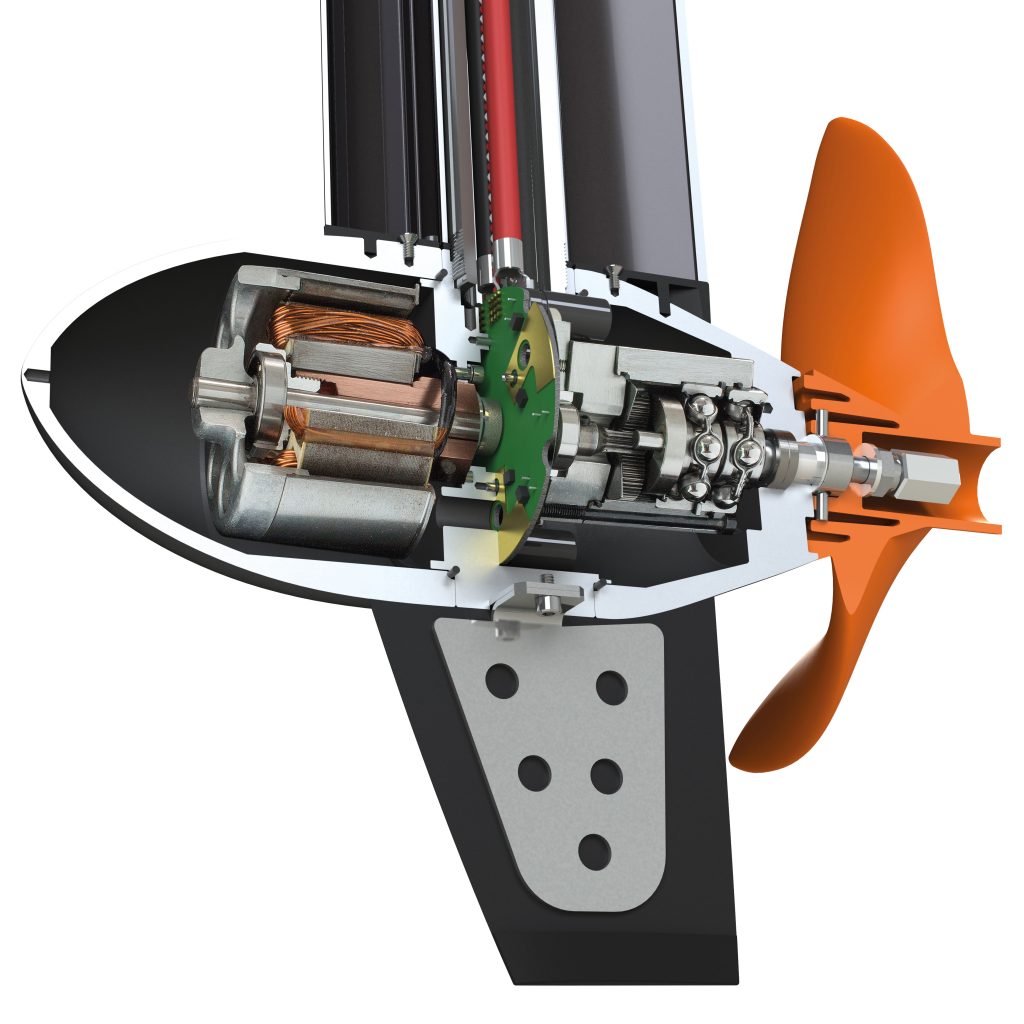
Types of electric boat motors
Electric outboard boat motors.
Some of the first electric outboards to hit the recreational boating market were smaller electric motors, typically used as trolling motors on fishing boats.
Today, it’s possible to buy far more powerful electric outboard motors in the 1 to 80 hp (.75 to 60 kW) range , with ever more powerful versions hitting the market each year. In 2022, Norwegian start-up, Evoy launched the world’s most powerful outboard to date, the 225kW Storm, a 300-hp beast of an electric outboard!
The range on electric outboard boat motors varies dramatically depending on your boat, total weight, propellor, and battery capacity .
The range also depends on how fast you want to travel. If you go slowly you’ll have a much greater range.
For instance, at a slow speed (5 knots) Torqeedo’s Deep Blue 50R , a 50 kW motor (80 hp equivalent) with a 40 kWh battery, has a listed range of 33-100 nm. But at full throttle (20-25 knots), the listed range drops to 16-20 nm.
To get a better sense of what range to expect on your boat (at both low and high speeds), you can look at the manufacturer’s website. See our list of electric outboard brands below.
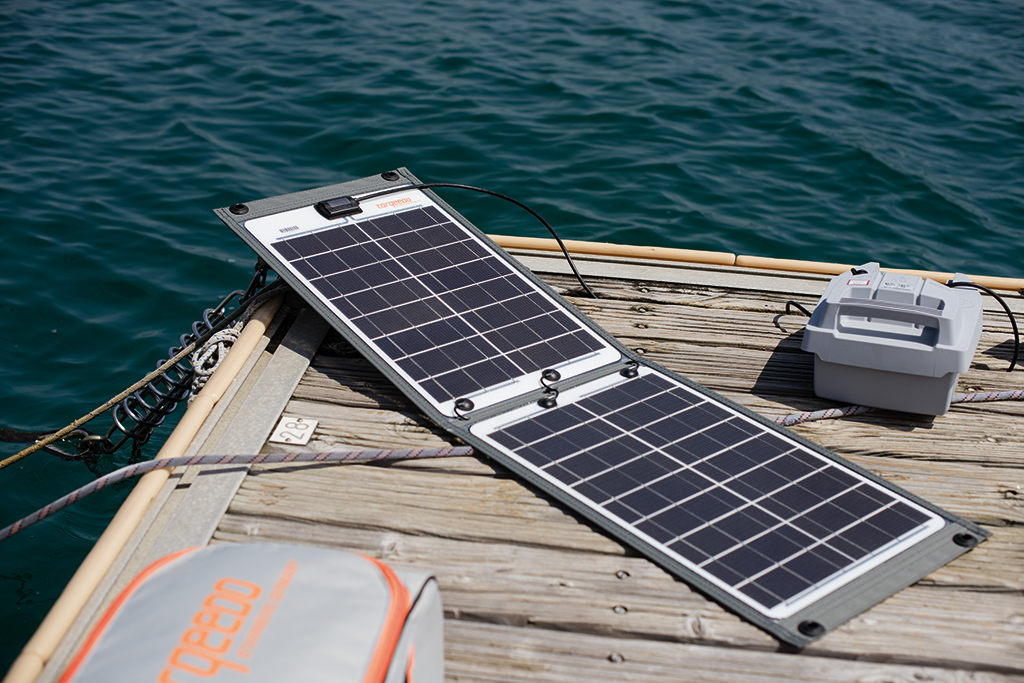
One of the great things about electric outboards is that they can use renewable power sources. So, for instance, you could plug your boat into a portable solar panel while picnicking and get an extra boost for the trip home.
Some electric outboard boat motors can even generate power! Motors with hydro regeneration capabilities can charge the batteries while the boat is being towed or under sail.
While hydro regeneration is a fairly new feature for electric outboards, some manufacturers, like EPropulsion, are offering it across their outboard product line.
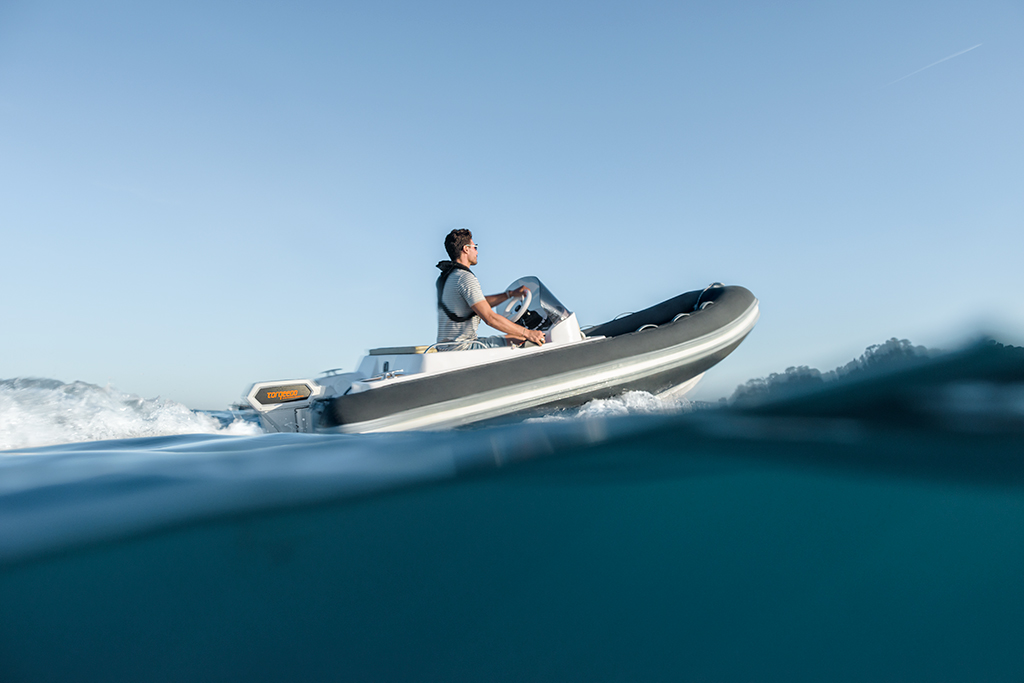
Key features of electric outboard boat motors
Each electric outboard motor brand has slightly different standard offerings and add-on features. Here are some of the key features and options to look for.
- Waterproof. Some electric outboards are fully sealed and designed to withstand immersion
- Remote controls. Choose between tiller and remote throttle controls
- On-board computers . Some electric outboards come with chartplotter connectivity, navigation functions, sonar, GPS anchoring, and autopilot features
- Built-in or stand-alone batteries. Some of the smaller motors come with built-in batteries, while the larger ones have separate battery packs
- Battery monitoring and tracking systems that calculate and display the remaining range in real-time
- Shaft length. Electric outboards come in both short and long shaft lengths to accommodate a variety of applications.
- Hydro regeneration capabilities
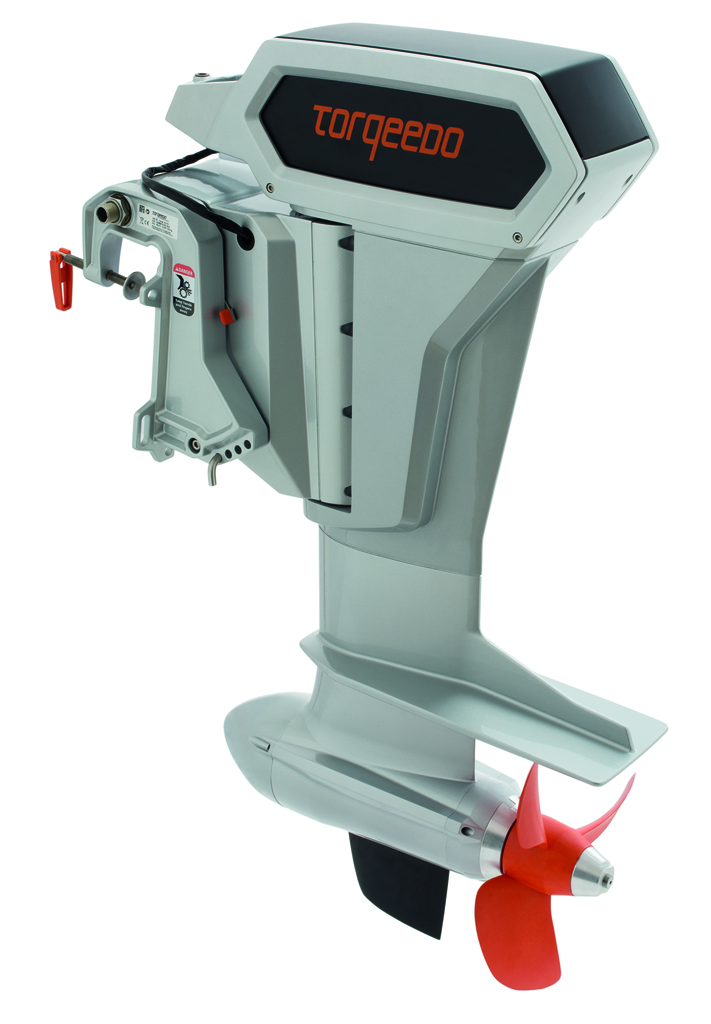
Electric outboard manufacturers
These electric outboard boat motor manufacturers (listed in alphabetical order) range from small startups to large companies and serve the North American market.
If you’re looking to learn more about what each of these companies offers (and how they compare) I’d highly recommend checking out the Plugboats’ electric outboard guides and directories . Jeff Butler, the editor at Plugboats has done a great job of compiling motor specifications from across the market.
Headquartered in San Diego, California, Bixby makes a small electric motor system for kayaks, inflatable boats, canoes, and paddleboards.
Elco has been building electric motors for 125 years and counts the likes of Henry Ford and Thomas Edison among their customers. Their award-winning electric marine motors range from 5 to 50 hp. The company is based in Lake George, New York, and its electric motors can be found on boats around the world.
Flux Marine
Flux Marine was founded by mechanical engineering Princeton grads and offers three outboard models—a 40 hp, 70 hp, and 100 hp. In 2021, they won an award for the best new green product at the Newport International Boat Show.
Joe Grez, a consumer product developer from Washington, invented the EP Carry , a compact, ultralight electric outboard system because he was concerned about exposing his young daughter to the carbon monoxide (CO) emissions produced by gas outboards.
The EP Carry retails for $1,600 and is a great size for small vessels like dinghies, canoes, inflatable boats, and kayaks.
ePropulsion
ePropulsion , based in Guangdong, China, manufactures 3 to 9.9-hp electric motors for sailboats, fishing boats, as well as dinghies and tenders. They all come with hydro regeneration capabilities.
Mercury Marine launched the Avator 7.5 electric outboard (3.5 hp equivalent) in early 2023. The leading outboard manufacturer is currently developing more powerful 20e and 35e models which it plans to release later this year.
In 2023, Newport , a well-known US-based inflatable boat manufacturer, launched three small outboards ranging from 1.8 to 3 hp.
If you’re into fishing, you’re probably familiar with the Minn Kota name, derived from MINNesota North DaKOTA, prime fishing country where the company has its roots. They introduced their first electric trolling motor back in 1934 and they’ve been making them ever since.
Pure Watercraft
Pure Watercraft was founded by CEO Andy Rebele in Seattle in 2011. Their 25 kW (50 hp) motor starts at $16,500.
Ray Electric Outboards
Ray Electric Outboards is a 3rd generation family-owned business based in Cape Coral, Fl. They manufacture one outboard model that can be operated at different power ratings ranging from 10 to 22 hp.
Stealth Electric Outboards
The 50 and 75-hp Stealth electric outboards were developed by Scott Masterston of Houston, Texas.
German manufacturer, Torqeedo , has been leading the propulsion industry for years and sells some of the best e outboard motors in the 1 to 80-hp range
Vision Marine Technologies (formerly The Canadian Electric Boat Company).
Based in Quebec, Canada, Vision Marine Technologies has been in the boating industry for 25 years and produced some very innovative electric boats. In 2021, they launched E-Motion 180E, one of the most powerful electric outboards on the market.
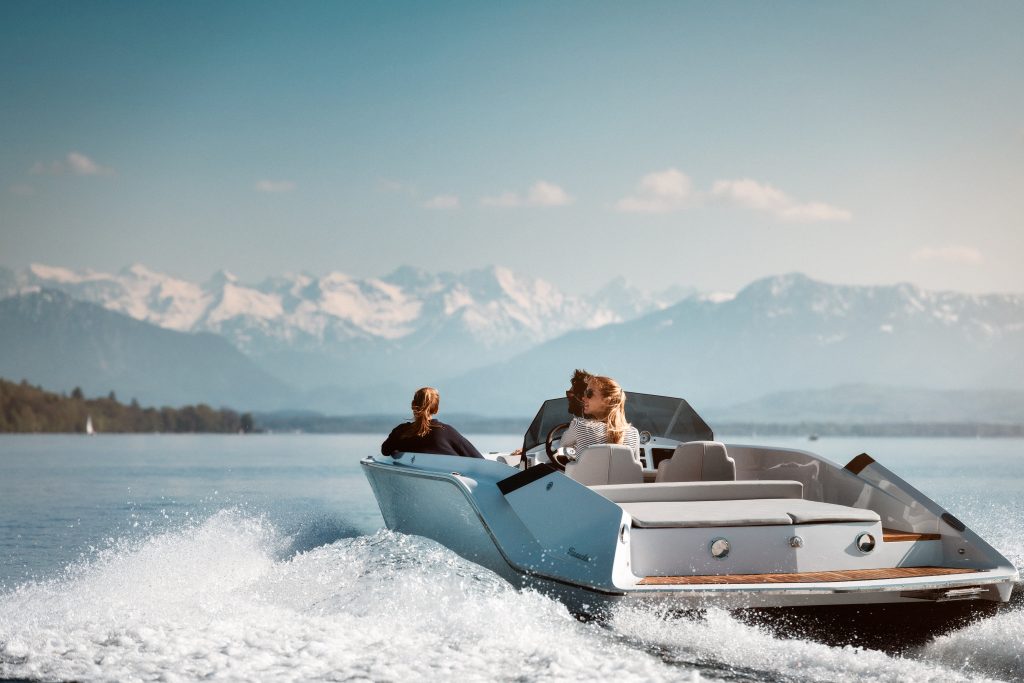
Electric inboard boat motors
Today’s electric inboard motors can provide anywhere from 3- to a whopping 330 hp (2 to 246 kW) and are used in a range of applications from heavy displacement vessels to fast, planing powerboats.
Similar to outboards, the range on electric inboard engines will vary based on your boat, load, battery capacity, and boat speed (among other things).
However, with an inboard electric boat motor, you have the option of a hybrid motor which can significantly extend your range. We’ll discuss the pros and cons of hybrid boat motors later in this post.
Sailors may also want to consider choosing an inboard electric motor with hydro regeneration capabilities. These electric power motors can charge the battery while the boat is under sail.
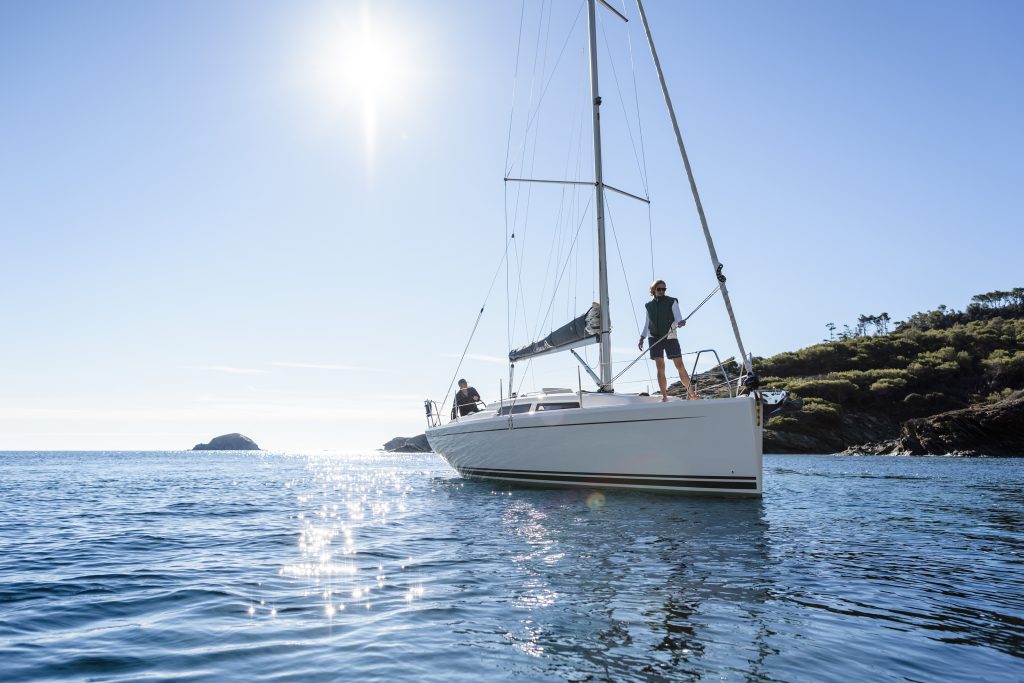
DIY electric inboard boat motor conversion
One way to save money on an electric inboard is to do the installation yourself. There are a few DIY electric inboard boat motor conversion kits available on the market.
I’ve spoken with a few sailors who’ve had great success replacing their inboard diesel engines with these electric boat motor conversion kits from Thunderstruck-EV , an electric drive manufacturer in Santa Rosa, California.
Key features of electric inboard boat motors
Each brand has a slightly different set of electric inboard motor options. Here are some of the key features and options to look for.
- DIY conversion kits
- On-board computers and touchscreen display
- Waterproof system components
Electric inboard manufacturers
US manufacturer, Elco Motor Yachts , has been building electric motors for over 125 years, having gotten their start in 1893, supplying electric boats for the Chicago World’s Fair. They have seven inboards ranging from 6 to 200 hp.
Electric Yacht
Electric Yacht is a US supplier focused on providing plug-and-play electric motors for DIY installations on sailboats. Their electric propulsion systems range from 10 to 30. They’ve had over 450 installs in 10 years of production.
Oceanvolt is a leader in regenerative systems and their electric inboard motors are popular among sailors. They offer shaft drive systems ranging from 6 to 60 hp.
Torqeedo, a German manufacturer, is the world’s leader in electric boat motors. They have two lines of inboards, one for displacement boats and another for fast planing boats. Their Deep Blue inboard systems range from 25 kW to 100 kW (40 to 135 hp)
Hybrid systems
Hybrid systems combine an electric motor and combustion engine, so you can cruise in silence (but know you’ve got enough gas to get home). These systems offer many of the benefits of pure electric motors, without the limited range.
If you want additional power for onboard luxuries like air-conditioning, hybrids can also provide a significant increase in house-side fuel efficiency.
The downside to any hybrid solution is that the systems are far more complex . Not only do they require more equipment, but, for an optimized system, you’ll need highly sophisticated software to manage multiple power sources and switch back and forth between diesel and electric.
Unsurprisingly, the increased complexity adds cost, making hybrids less economical than either a conventional or pure electric install.
Serial vs. parallel hybrids
As with cars, there are two types of hybrid systems: serial and parallel. A serial hybrid uses a generator to power a large electric motor connected to the drive shaft. Whereas, a parallel hybrid has both a conventional combustion engine and a small electric motor connected to the drive shaft.
There are plenty of factors to consider when choosing between a parallel and serial system. Marine mechanics and electrical expert, Nigel Calder, does a great job of explaining serial and parallel hybrids in detail.
In general, serial systems may be a better fit for boats that can get most of their propulsion energy from renewable sources (e.g., a sailing catamaran). Whereas, a parallel system makes more sense on boats that regularly require sustained propulsion (e.g., Greenline’s power yachts ).
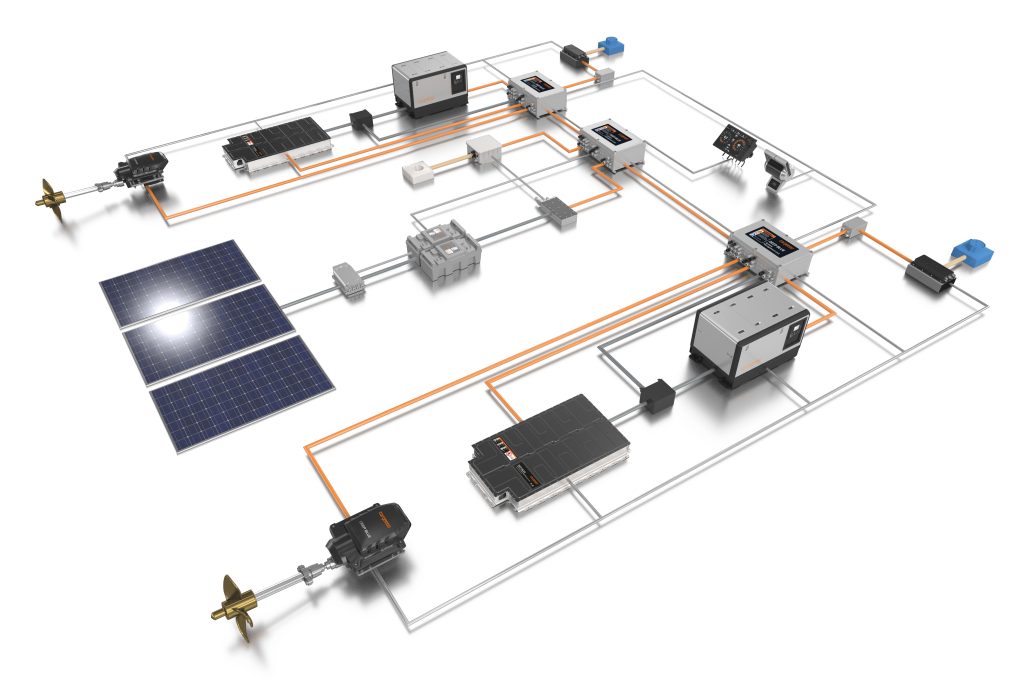
Key features of marine hybrids
- Parallel and serial hybrid options
- Integrated energy management systems
Marine hybrid manufacturers
Elco motor yachts.
Elco manufactures serial, parallel, as well as a combined serial-parallel system. Their systems can be used on sailboats, trawlers, yachts, and boats up to 85′ feet.
Hybrid Marine Ltd.
Hybrid Marine sells parallel hybrid systems in the 10 to 230 hp range. Beta, John Deere, and Yanmar’s hybrids all incorporate Hybrid Marine technology.
Finnish manufacturer, Oceanvolt , offers serial hybrid systems for both sailboats and powerboats.
Torqeedo makes hybrid systems for yachts up to 120 feet as well as powerful motorboats.
Electric pod drive and sail drive
Several manufacturers are now making electric pod and sail drives. These electric drive systems are more efficient and can save space onboard.
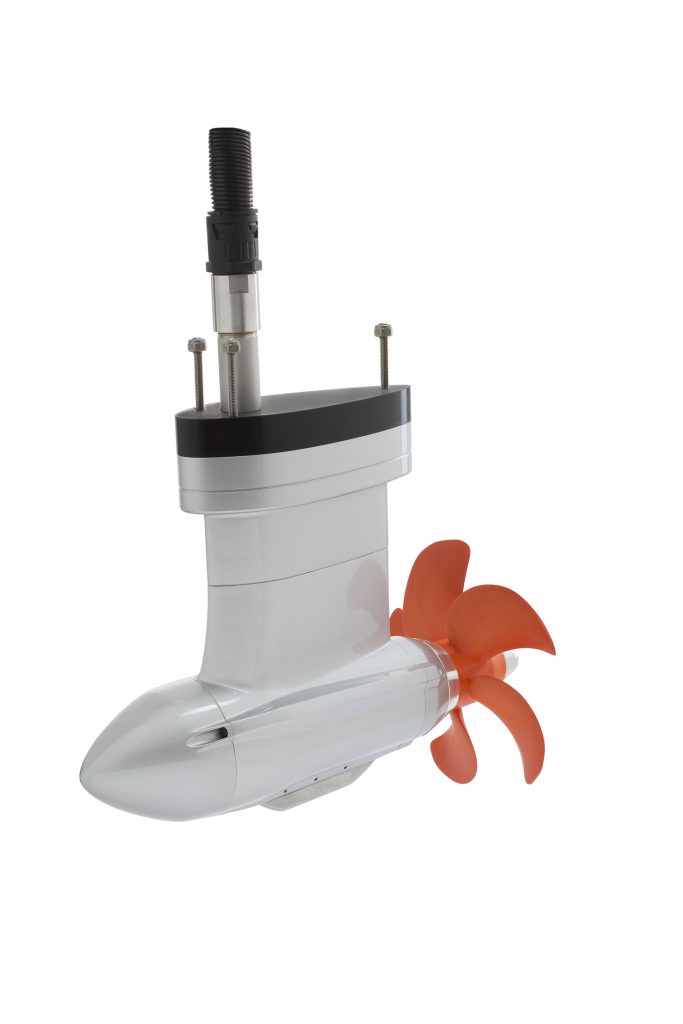

Electric pod and sail drive manufacturers
Electric Yacht produces a range of sail drives that can replace diesel engines up to 75 hp.
propulsion sells a 3 hp, 6 hp, and 9.9 hp fixed pod drive.
Oceanvolt’s sail drives range from 6 kW to 15 kW (8 to 20 hp)
Torqeedo sells a 40 hp and 80 hp equivalent electric sail drive as well as electric pod drives in the 6 to 25 hp range.
While it’s possible to power an electric motor with a conventional lead-acid battery, there are many good reasons to upgrade to lithium-ion batteries.
Their increased usable capacity is roughly double what you can get out similarly sized lead-acid battery. More battery capacity means more range—and hours of fun—on your electric boat.
They also charge more quickly and have a longer life span than lead-acid batteries. Unlike flooded lead-acid batteries, which need to be watered, lithium-ion batteries are practically maintenance-free.
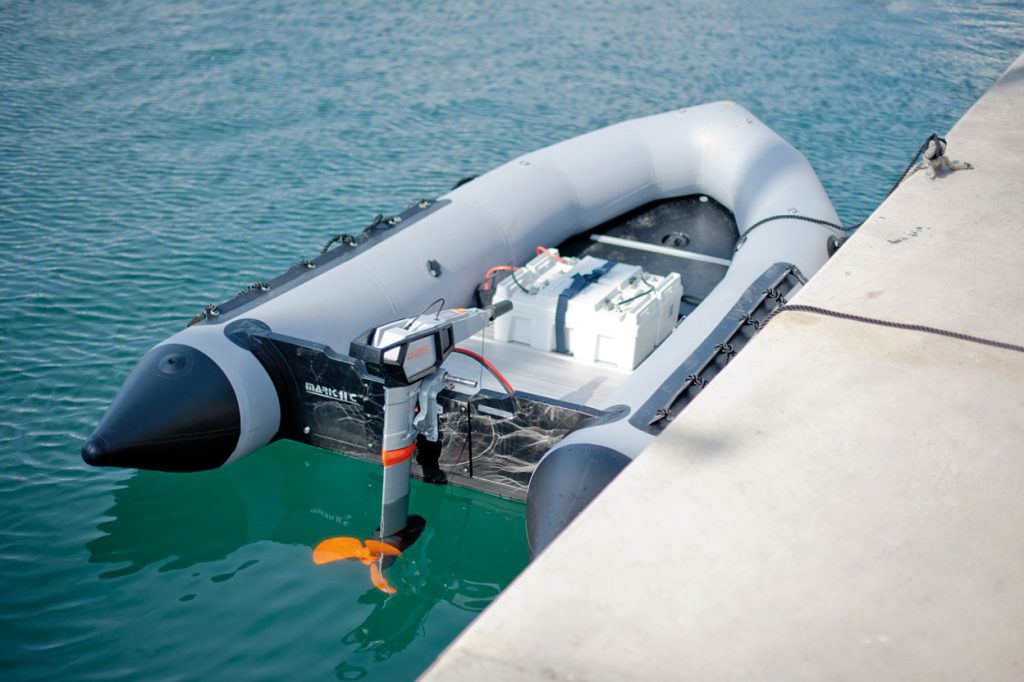
The downside is that lithium-ion batteries are far more temperature-sensitive and can’t be charged much above 113 F (45 C) or below 32 F (0 C).
They can also present major safety issues . Lithium-ion batteries can go into what’s known as thermal runaway—a self-heating process that can cause the battery to catch fire.
Simply put, lithium-ion batteries are NOT a drop-in substitute for lead-acid batteries. They need to be specially designed for the marine environment and paired with a robust battery management system.
Electric motor manufacturers often provide complete solutions (including motor, batteries, and battery management system). It’s a good idea to work with a manufacturer with extensive marine experience and an ABYC-certified technician on any installation.
The other catch is that lithium-ion batteries cost two to four times as much as lead-acid batteries. However, the increased capacity and longer life span may make lithium batteries a better value option over the long run.
Ready to catch the electric boating wave?
With ever more powerful and feature-packed electric options launching each year, it’s an exciting time to be in the market for a new motor or engine. If you have any doubts about whether an electric boat motor is right for you, head to your local boat show and see, first hand, what all the buzz is about.
Fiona McGlynn is an award-winning boating writer who created Waterborne as a place to learn about living aboard and traveling the world by sailboat. She has written for boating magazines including BoatUS, SAIL, Cruising World, and Good Old Boat. She’s also a contributing editor at Good Old Boat and BoatUS Magazine. In 2017, Fiona and her husband completed a 3-year, 13,000-mile voyage from Vancouver to Mexico to Australia on their 35-foot sailboat.
Douglas McQuilken
Sunday 30th of January 2022
Great article!
For those who wish to collaborate with prospective & current electric boaters, highly recommend this forum - https://groups.io/g/electricboats
Thanks for the suggestion, Douglas!
Terms and Conditions - Privacy Policy
- New Sailboats
- Sailboats 21-30ft
- Sailboats 31-35ft
- Sailboats 36-40ft
- Sailboats Over 40ft
- Sailboats Under 21feet
- used_sailboats
- Apps and Computer Programs
- Communications
- Fishfinders
- Handheld Electronics
- Plotters MFDS Rradar
- Wind, Speed & Depth Instruments
- Anchoring Mooring
- Running Rigging
- Sails Canvas
- Standing Rigging
- Diesel Engines
- Off Grid Energy
- Cleaning Waxing
- DIY Projects
- Repair, Tools & Materials
- Spare Parts
- Tools & Gadgets
- Cabin Comfort
- Ventilation
- Footwear Apparel
- Foul Weather Gear
- Mailport & PS Advisor
- Inside Practical Sailor Blog
- Activate My Web Access
- Reset Password
- Pay My Bill
- Customer Service

- Free Newsletter
- Give a Gift

How to Sell Your Boat

Cal 2-46: A Venerable Lapworth Design Brought Up to Date

Rhumb Lines: Show Highlights from Annapolis

Open Transom Pros and Cons

Leaping Into Lithium

The Importance of Sea State in Weather Planning

Do-it-yourself Electrical System Survey and Inspection

Install a Standalone Sounder Without Drilling

Rethinking MOB Prevention

Top-notch Wind Indicators

The Everlasting Multihull Trampoline

In Search of the Snag-free Clew

What’s Involved in Setting Up a Lithium Battery System?

Reducing Engine Room Noise

Breaking Point: What Can Go Wrong With Your Yanmar?

Mildew-resistant Caulks for Boats

Can We Trust Plastic Boat Parts?

Repairing Molded Plastics

Mailport: Marine plywood, fuel additives, through bolt options, winch handle holders

The Day Sailor’s First-Aid Kit

Choosing and Securing Seat Cushions

Cockpit Drains on Race Boats

Rhumb Lines: Livin’ the Wharf Rat Life

Safer Sailing: Add Leg Loops to Your Harness

Resurrecting Slippery Boat Shoes

Tricks and Tips to Forming Do-it-yourself Rigging Terminals

Marine Toilet Maintenance Tips

Learning to Live with Plastic Boat Bits

The Ultimate Guide to Caring for Clear Plastic
- Inside Practical Sailor
Portable Electrical Propulsion for Small Sailboats
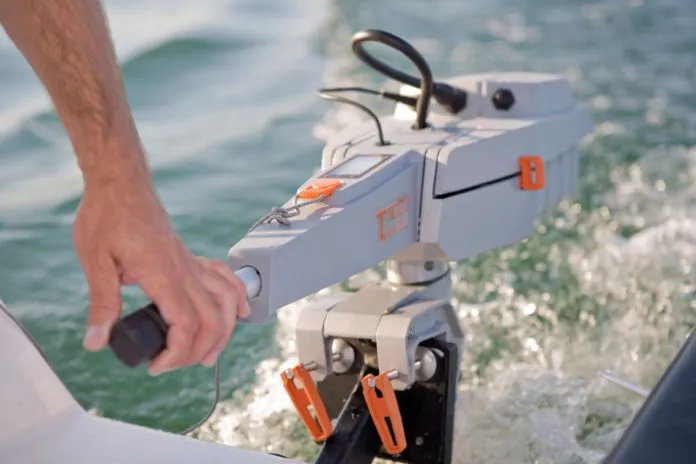
Courtesy of Torqeedo
In part one of our two-part test of five and six-horsepower engines in the upcoming January issue of Practical Sailor, we take a second look at portable electric motors. Practical Sailors interest in modern portable electric propulsion dates back to 2004, when then editor Doug Logan began to lose faith in the two-stroke outboard on his Boston Whaler. While awaiting the prognosis on his unresponsive 15-horsepower Evinrude, he bought a Minn Kota Riptide 55 trolling motor, wondering if it might make a good dinghy engine.
Logans initial review of the Minn Kota focused on its potential as a dinghy motor but he also tested it on larger skiffs. We later heard from several Practical Sailor readers who use trolling motors to power their sailboats (some as large as 30-feet!), but most said they used them mainly for short distances and in mostly flat water. Prices on saltwater-rated trolling motors start at around $350 (a 12-volt deep cycle battery to power them adds at least another $120), making the initial costs much less than for other electric motors.
Although people often compare such trolling motors to the $2,000 Torqeedo Travel 1003, there are several key differences. The Torqeedo uses a dedicated lithium magnesium battery that has a longer life and a more favorable power-to-weight ratio than a lead-acid battery. The Torqeedos brushless motor design is more reliable and better suited for continuous duty.
In 2005, we tested four popular trolling motors with rated thrusts ranging from 40 to 80 pounds. The results highlighted a major drawback of all electric motors: available horsepower and range is closely tied to battery capacity. Driving a sailboat with one of the more powerful trolling motors at full throttle for more than a half an hourwill nearly drain a standard Group 24 battery. And you can’t expect a trolling motor to dislodge your Catalina 22 when a stiff wind has pinned it to the dock (a task that would challenge the Torqeedo Travel 1003 as well). Even with these drawbacks, a trolling motor is a viable option for sailors who just need a little help getting up a canal or off a dock in calm water.
If you need more power, there are other options. In our most recent foray into electric outboards, we tested a motor called the SolidNav Traveler . The hefty 48-volt, four-horsepower outboard was manufactured by Parsun Power Machine, Chinas largest outboard exporter. The outboard’s brushless solid magnet motor was built by Mars Electrical Co. of Milwaukee, Wis. (now Motenergy). The engine looks nearly identical to a gasoline outboard of the same horsepower and weighs slightly more. Although the Solid Nav is no longer available, Elco is marketing a very similar mode l for about $3,000 suggested retail price. The price does not include the requisite four 12-volt batteries (or equivalent), which can add at least another $1,500-making the initial outlay much higher than any other electric motor option.
Our testers were impressed by the motor’s heavy duty design, and the way the electric motor was incorporated into the familiar gasoline outboard form factor. Performance was good, but again, it was limited by the constraints of electric power. In our test of the Solid Nav, four North Star Energy group 24 AGM batteries with 140 amp hour reserve capacity were wired in series to deliver the required 48-volts. This battery tank delivered about eight miles of range on our test boat (a 19-foot Cape Dory Typhoon) at four knots.
Of all the electric outboards available to the sailor, the Torqeedo holds the most promise, but the niche is rather narrow. This is the third time weve looked at these motors. In our first preview, we tested an early iteration of the Travel 801L , an ultralight electric equivalent of a two horsepower outboard. Four years ago, we tested the more powerful Torqeedo Travel 1003. We pitted it against the Electric Paddle, an ultralight portable electric motor that looks like a trolling motor but has a larger diameter prop and its own rechargeable battery.
With 30 percent more battery power than the 801, plus an increase in thrust and efficiency, the Travel 1003L (long shaft) has proved impressive on the variety of boats weve used it on including: a round-bilge carbon fiber dinghy from Wing Systems, the Cape Dory Typhoon, a 9-foot, 10-inch Dynamic RIB from Mercury, a Venture 22, and the Catalina 22.
As with all electric motors, power and range are limited. On our test boat, a Catalina 22, the range on a single battery at 4 knots speed is about 2.5 miles. At slower speeds of about 2.5 knots, the maximum range is about 7 miles. Maximum speed on the Wing Systems dinghy was about seven knots, but that could only be sustained for about half an hour. At slower speeds, range approaches 10 miles.
Bottom line: For the average daysailer with high power demands, a small gasoline outboard remains the most practical choice for portable propulsion. An electric motor can work, but for longer range service it will require significant investment in big battery banks, and perhaps a solar charging system. The limited range wont matter for the lake sailor who just needs the occasional short boost home when the wind dies. For this task, the Torqeedo is the most convenient and best suited, but for the budget-minded small boat sailor tired of the hassles of gasoline power, a trolling motor will also work within certain limits.
RELATED ARTICLES MORE FROM AUTHOR
If be interested to learn more about how to mount one of these motors on a sailboat without an open transom, such as my Lightning.
LEAVE A REPLY Cancel reply
Log in to leave a comment
Latest Videos

Island Packet 370: What You Should Know | Boat Review

How To Make Starlink Better On Your Boat | Interview

Catalina 380: What You Should Know | Boat Review
- Privacy Policy
- Do Not Sell My Personal Information
- Online Account Activation
- Privacy Manager
Electric boats
Mercury launches larger and more powerful electric outboard motors for small boats.
Mercury Marine has just announced the launch of its two newest electric outboard motors, the Avator 20e and Avator 35e.
The news follows the launch of Mercury’s first entry in the lineup, the Avator 7.5e, which splashed down earlier this year. And the company isn’t even finished yet, teasing another two electric products to be unveiled in the next few months.
According to Mercury, both the Avator 20e and 35e include many of the same innovative features that we first saw launched in the Avator 7.5e, including that motor’s industry-first transverse flux motor technology, as well as a full-color intuitive display and an ambidextrous tiller handle.
The new larger outboard models provide more power and the ability to connect multiple Avator batteries to extend range and run time, plus full access to the Mercury Marine app with the integrated SmartCraft Connect module. For larger boats, the motors feature remote steering as well.

On the spec side, the Avator 20e provides 2.2 kW of power and the 35e generates 3.7 kW of power, both measured at the propellor shaft.
As we’ve previously discussed , electric outboards generally provide similar performance to combustion engine outboards of significantly higher power output. That’s largely thanks to the impressive torque of electric motors and their higher efficiency operation.
For example, the 20e puts out less than 3hp but is said to produce similar acceleration to a 5hp FourStroke outboard, while the 35e generates acceleration that is comparable to a Mercury 9.9hp FourStroke outboard that technically offers twice the 35e’s rated power.
In addition to being more power dense, the company says the electric outboard motors are also 63% quieter than comparable combustion engine outboards.
Both models can come with either tiller or remote steering. Mercury says they are ideal for powering small vessels such as aluminum fishing boats, micro skiffs, rigid inflatables, tenders, and small pontoon boats.
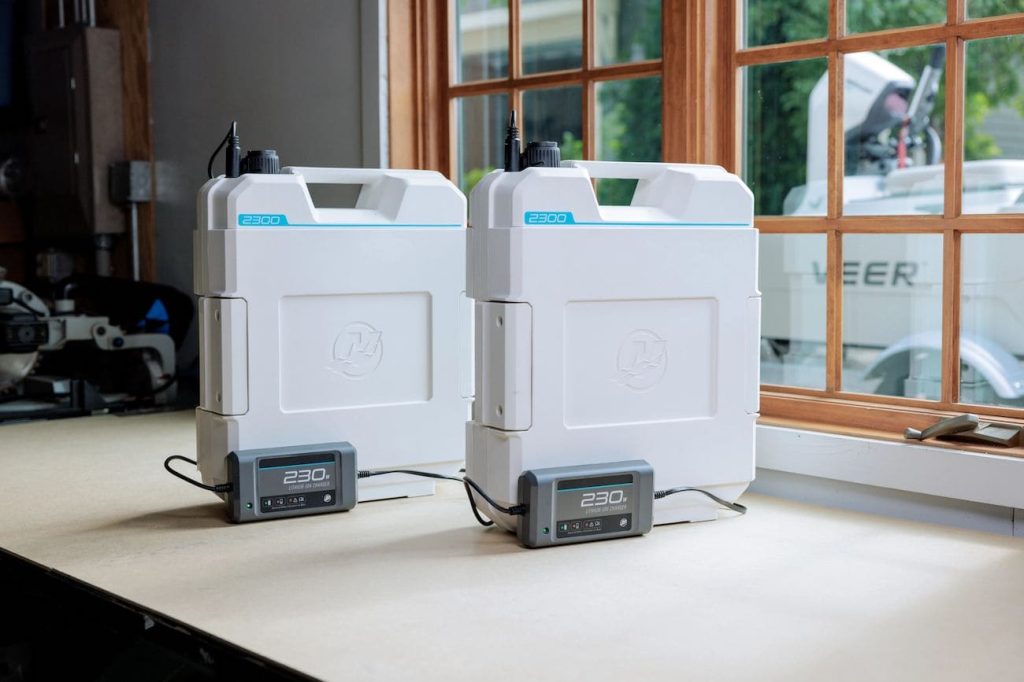
Top comment by OrangeMagnet
When comparing ICE to electric, one has to look at the cost of operation, maintenance, and battery replacement. I have a 5 year old electric riding mower and it has shown to be 17 times less expensive to run than a comparable ICE powered mower. No one seems to record the cost of fuel and maintenance they put in their ICE devices and have no idea what the cost savings might be. The other idea is that batteries are wear out items and will likely need replacement during the life of the device. What do the batteries cost and how long will they last before they have to be replaced? The batteries in my mower cost $660 to replace and saved more than that in gas and maintenance before they needed replacement.
As Mercury Marine VP of Product Development and Engineer Tim Reid explained:
Avator outboards are intelligent, electric propulsion systems engineered to deliver a superior boating experience with flexibility to easily extend range and runtime. Up to four of Mercury’s new 2300Wh batteries can be connected and managed through our exclusive Power Center which safely merges power, enables communication between the batteries and outboard, and allows single point charging.
A revolution in small electric boats
The last several years have seen a wave (yep) of new electric boats enabled by the influx of small electric outboard motors and marine batteries.
Mercury’s sister company Veer recently launched with an interesting 13 foot (4 meter) electric boat , and many other competing products are also joining the market.
While high-end electric boats are still reserved for those with deep pockets, these smaller format electric outboards are making electric boats more accessible to average boaters than ever before.
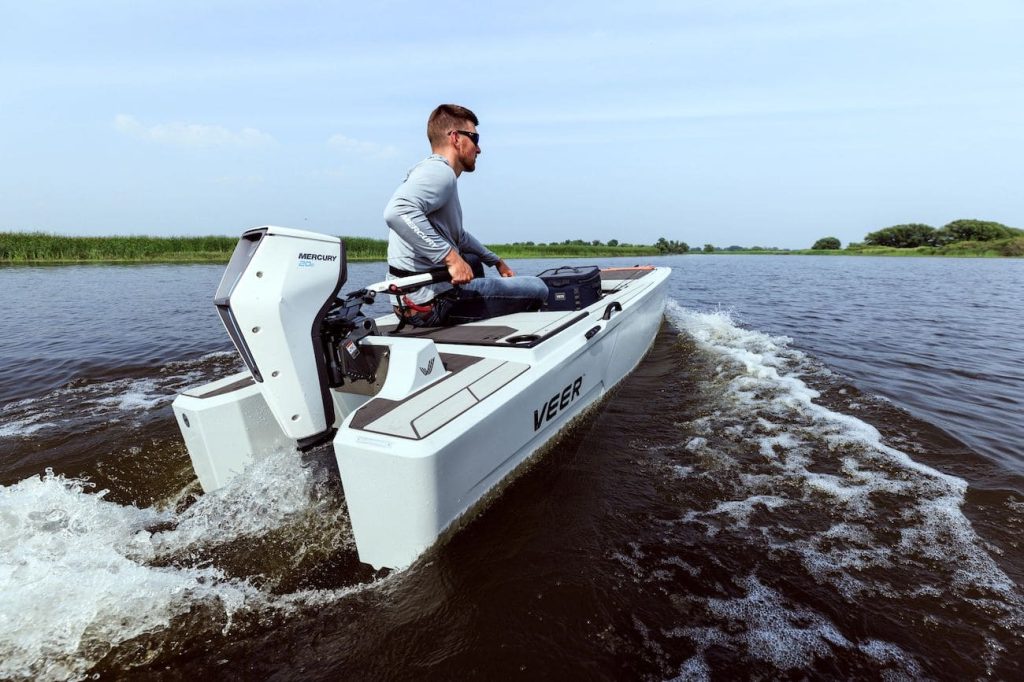
FTC: We use income earning auto affiliate links. More.

Micah Toll is a personal electric vehicle enthusiast, battery nerd, and author of the Amazon #1 bestselling books DIY Lithium Batteries , DIY Solar Power, The Ultimate DIY Ebike Guide and The Electric Bike Manifesto .
The e-bikes that make up Micah’s current daily drivers are the $999 Lectric XP 2.0 , the $1,095 Ride1Up Roadster V2 , the $1,199 Rad Power Bikes RadMission , and the $3,299 Priority Current . But it’s a pretty evolving list these days.
You can send Micah tips at [email protected], or find him on Twitter , Instagram , or TikTok .
Micah Toll's favorite gear

Lectric XP 3.0 e-bike sale
Best $999 electric bike ever!

Rad Power Bikes sales
Great e-bikes at great prices!
- Spirit 1.0 Plus
- Spirit 1.0 Evo
- Pod Drive Evo
- E-Series Battery
- G102-100 Battery
- Find a Dealer
- Have a Dealer Contact Me
- Product Registration
- Support Center: FAQ & Guide
- Video Tutorial
- Download Center
- Performance Bulletins

Best Small Outboard Motors: A Comprehensive Buying Guide
Small outboard motors are perfect propulsion solutions for small boats, including dinghies, tenders, canoes, kayaks, skiffs, and Jon boats.
However, mind that small outboard motors are not trolling motors that only provide limited power and range (Check our previous post comparing outboard motors vs trolling motors ).
A reliable small outboard motor should be lightweight and quiet, yet powerful enough to get you from point A to point B effortlessly, even when dealing with tides or swift rivers.
Having searched around and found yourself overwhelmed by nearly endless options of small boat motors with mixed reviews? Making it even ‘worse’, now you have affordable options of small electric outboards.
No worries. In this post, we will have a detailed comparison between portable electric boat motors, small gas outboards, and other options available (such as trolling motors), with the best recommendations to help you make a quick decision.
Table of content:
- Electric vs. Gasoline
- Best Small Boat Motors
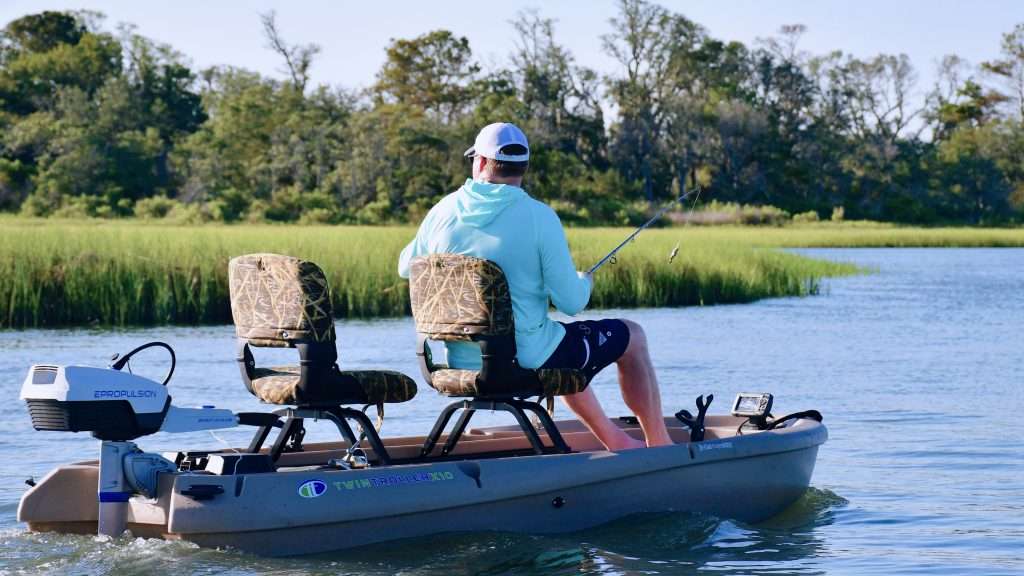
Small Outboard Motor: Electric vs. Gasoline
Here we list the top 5 reasons and occasions you should consider an electric outboard vs. a gas small boat engine.
‘I’m searching for the quietest small outboard possible.’ A quiet ride is one of the benefits of small outboard motors compared with those big engines.
If you want to cruise silently up and down the river, the best solution is to go electric. The electric small outboards are surprisingly quiet because they don’t rely on the internal combustion which causes loud noise and vibiration.
Thanks to the industry leading direct drive technology and FOC (Field-Oriented Control) built into the small outboard motors, ePropulsion outboards further reduce the number of internal moving parts and eliminates the gearbox, making the quietness a next level. You will simply hear no noise but the sound of nature.
Here is a video comparison between small gas boat motors and their electric counterparts:
Key takeaway: If quietness is your top priority, small electric outboards will be your best choice. You will feel the difference immediately once you switch over to electric motors.
#2. Lightweight
Portability is another crucial factor for users to choose small boat engines. Usually, the small portable outboards can be hand-lifted easily, making them easy to transport, attach and remove from your boat. The weight for gas and electric small outboards is neck and neck, generally ranging from 9 kg – 10 kg for a 3 HP outboard motor.
However, don’t forget to include the weight of gasoline required (for small gas outboard motors) and the battery pack (for electric motors). The electric small boat motors usually come with built-in batteries for easy installation and transportation, making it a more portable solution.
#3. Power & Range
The power is a big drawback for some lightest (or cheap) small outboard motors. With those smallest boat motors, such as trolling motors rated by thrust, users might have difficulty moving forward when caught in the gale or tide, even at its max speed.
If you need more power to help you feel safer on water, you need to consider some higher-powered small outboards, and 2.5 or 3 hp small outboards can be a good starting point to deal with the possible elements on water.
For example, the 3 HP small outboard ePropulsion Spirit 1.0 Plus gives you 4.5 mph speed, 5 hours runtime and 22 miles range with a single charge of its 1276 Wh battery (tested on a 12-foot aluminum boat with one person on board in calm water).
#4. Easy to Use & Maintain
Forget about the ignition and pulling the cord every time to start the small gasoline outboard motor. With electric boat motors, you only need to press one button and you are ready to go. It’s simple to use for all your family members.
Electric outboard motors are made for a premium experience. It’s easy to operate with the built-in tiller handle, and you will stay informed of the real-time battery status with its convenient digital display. So no worries about getting stuck in the middle of a lake.
Some small boat motors featuring direct drive technology are maintenance-free, saving you a lot of trouble and money in the motor service.
The price might be a big reason that puts off your decision on buying a electric small outboard motor. Some of you might be looking for small boat motors for sale or cheap small boat motors resellers on the market.
It’s true that the initial investment is higher than the petrol counterpart, but you will be compensated by the savings on petrol cost, maintenance fees, and the superium experience it provides. You will be surprised that you will start to save within a few years of use (about 150 hours of service time), according to our calculation .
If you want to save some budget on the small outboard motors, you can pay attention to online and offline activities to get some hot deals and save money. For example, you can get a discounted ePropulsion small outboard motor by becoming our pro staff .
Best Small Boat Motors: Top 2 Options
As we have discussed above, electric small outboard motors can be your ideal solution for small vessels in terms of the motor weight, power, range, and cost in the long run.
So what’s the best option for a reliable small outboard? Does anyone have a brand they suggest?
Check out the top two electric small outboard motors models recommended by industry professional reviewers and customers from over 40 countries.
#1. Spirit 1.0 Plus: 3 HP
As one of the most popular selling models, Spirit 1.0 Plus has everything you may expect from a small outboard motor, plus extended battery life and long range.
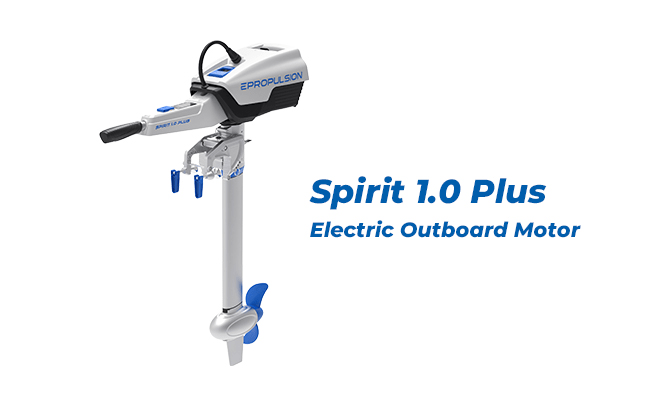
Designed for dinghies, fishing boats, and sailboats, Spirit 1.0 Plus is suitable for various applications, providing you with enough power to go fishing all day long at trolling speed.
Performance:
Features you will love:
- Quiet, no noise to disturb your journey
- Clean power, environmentally friendly
- Portable, easy to install and transport
- Easy to use, all family members can enjoy the fun
- Digital display, real-time access to battery status
- Integrated floating battery
- Solar charging supported
- Free of maintenance, saving cost and trouble
Customer Reviews:
‘Tried our spirit 1.0 plus for the first time today on our old tender dinghy and the difference between that and the old gas motor is amazing. Not just noise and smell. But performance too.’
The above comment is quoted from Miles Buckhurst’s sharing on ePropulsion Owners Group. Here is also a video that compares ePropulsion small outboard motors with other alternatives (trolling motors and more). Check it out for details:
In addition, ePropulsion offers three years warranty upon product registration . So you are covered if anything happens to your ePropulsion small outboard motor.
#2. Spirit 1.0 Evo: 3 HP
Spirit 1.0 Evo has inherited all the benefits from the Plus model and innovatively been integrated with the extra hydro generation function.
It allows the battery to be charged while sailing. If you are looking for a small outboard motor for your sailboat, Spirit 1.0 Evo would be a better fit.
For the hydro generation charging capacity and more genuine comments, you may check out the below review video from The Sailing Frenchman:
If you still need more battery capacity for a longer trip, you can check out ePropulsion E-Series batteries that provide extended runtime at an affordable price.
Small outboard motors bring a lot of convenience and premium experience to your boating activities. Whether you plan to use it for roaming around the small shallow river near your place, or want to go long ways and come back to the start points upriver and against the current, you would be happy and safe with a reliable small outboard motor.
Recent Posts

ePropulsion Sustainably Mobilizes Hundreds of Sightseeing Bamboo Rafts on the Guilin Li River

Bass Boat Motors: The Only Guide You Need in 2024

ePropulsion’s Revolutionary eLite Electric Outboard Motor Wins Innovation Award in Miami
Can. I buy this motor in Canada?
Hi Bruce, we have several dealers in Canada. You can fill out this form and the one closest to you will contact you soon. Meanwhile, you can actively find a dealer on our official website. https://www.epropulsion.com/find-a-dealer/
Join the discussion! Cancel reply
Save my name, email, and website in this browser for the next time I comment.
Notify me via e-mail if anyone answers my comment.
This site uses cookies to personalize your experience and analyze site traffic. By clicking accept or continuing browsing the site, you are agreeing to our use of cookies. See our Privacy Policy here .
View the Serial Number
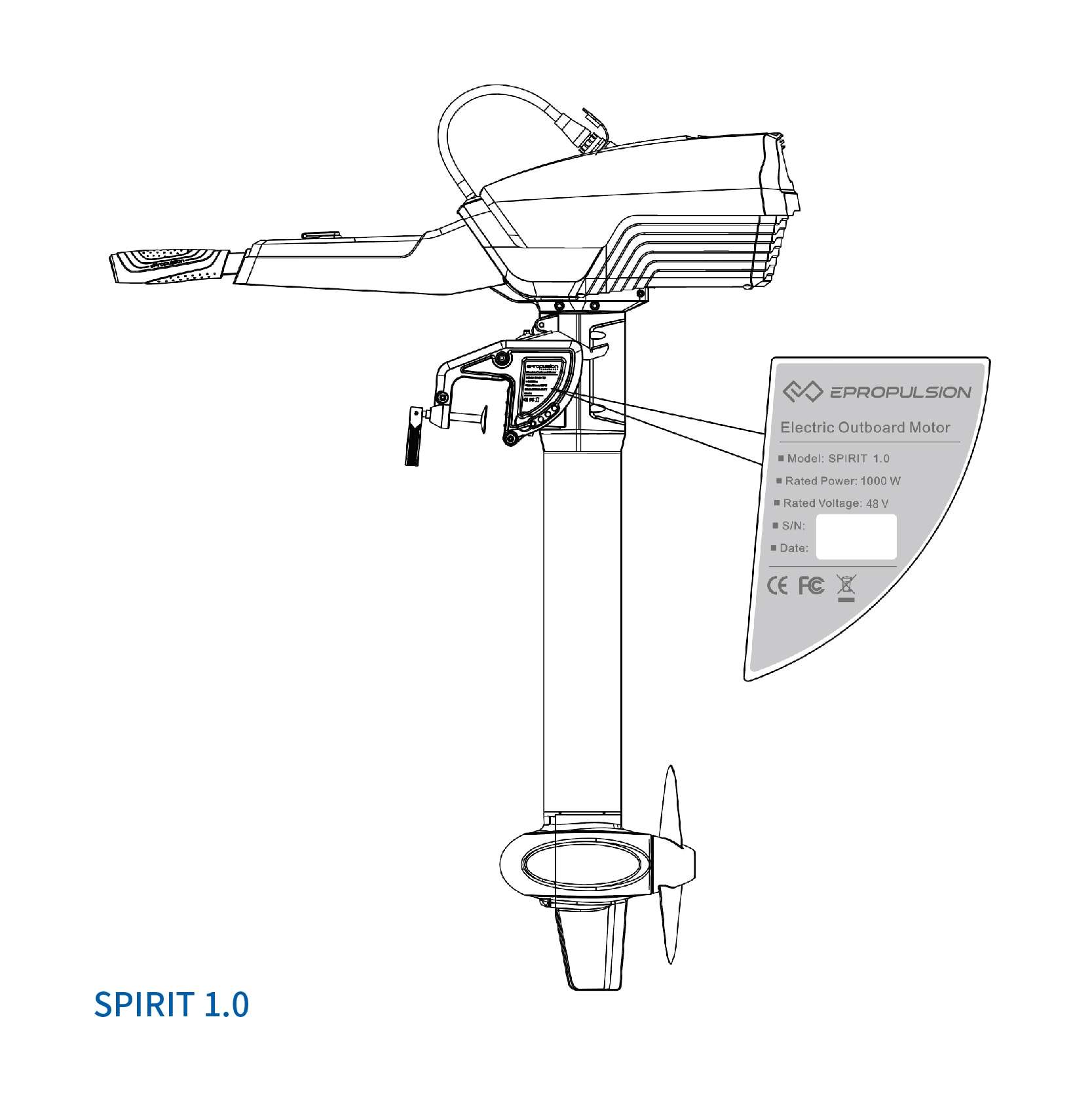

IMAGES
VIDEO
COMMENTS
Weight: 27.1kg Power: 750W / 1hp Battery: 1kWh Range: 34nm Price: $1,500. Announced in early 2022 and launched less than a year later, the Mercury Avator 7.5e is the first electric unit from the world's biggest builder of outboard engines.. The whole top plate hinges up to reveal the battery, which can be quickly removed from your electric boat or replaced for convenient charging.
With the Spirit 1.0 Evo electric sailboat motor, you can go 5.5 mph (8.8 kph) at top speed on the 21 ft RS21 sailing boat, or troll for 20 hours continuously at 2.2 mph (3.5 kph) according to our test. This electric sailboat motor with regeneration allows you to recover energy from the prop while under sail.
Motor weight: 10.5kg. Battery weight: 9kg. Battery capacity: 1276Wh. Top speed RIB: 4.5mph. Top speed skiff: 6.0mph. Thrust: 31kg/68lbs. The Chinese firm ePropulsion has been developing its electric outboard motor range and lithium batteries for some time. We tested the Spirit 1.0 Plus and Evo, both 1kW motors with integral batteries.
2) ePropulsion Navy 6.0. If you are looking for something longer lasting than and more powerful than the Spirit 1.0 Plus, ePropulsion also offers the more powerful Navy 6.0. The Navy 6.0 is equivalent to a 10Hp engine, so it won't struggle to move a relatively big boat. The range on the Navy 6.0 is impressive.
The TEMO 1000 is a 1 kW portable outboard with a low-profile and unique design. It's an alternative to the Torqeedo Travel, ePropulsion Spirit, and Mercury Avator. This is very low profile, with just a drive leg. The battery is a 15-pound (7 kg) lithium cartridge that gets inserted into the slim shaft.
The Mercury® Avator™ 7.5e electric outboard delivers speed and acceleration performance similar to a 3.5hp internal combustion outboard, making it ideally suited for a variety of small boats, tenders and as secondary power on sailboats. Available in tiller and remote steer models, it features a quick-connect battery and intuitive controls ...
The electric outboard boat motor needs a large battery capacity especially if you are planning for a long trip. ... 2500 lbs + 4 people) in Florida brackish inter coastal water. Used primarily for racing. I need a small motor with a long shaft for moving from dock to racing area, about 2 miles. Other identical boats use 2.5hp gas motors. Weight ...
The US-made EP Carry is the only outboard designed and optimized specifically for small boats. Dinghies, small skiffs, small sailboats, canoes and fishing kayaks that have unique design needs and speed-drag characteristics. EP Carry's portability, reliability, longevity, power, and range satisfies these needs, and its lightweight simplicity ...
This site is focused on electric outboard motors for sailboats up to 27ft, and up to 5,000 lb. displacement. Which motor for my boat? How much power do I need As previously discussed, boat speed is directly affected by boat hull design, displacement weight, wind, waves, and boat motor power. When it comes to motor power, diesel and gas-powered ...
35 feet 7.9 knots (9.1mph) With an electric outboard motor, or any kind of auxiliary motor, boat speed depends on the hull type, waterline length, and total displacement weight (including passengers, food, and baggage), as well as the motor thrust. Speed factors also include the waves, current, and wind, relative to your heading.
2-Stroke Engines - This is due to an overall lighter weight engine and higher torque. Diesel Engines - Diesel delivers more torque because the rate of compression is greater. Bigger Propellers - More surface area means more water displacement. Location - Motoring on lakes and rivers requires less power than open ocean.
Based in Quebec, Canada, Vision Marine Technologies has been in the boating industry for 25 years and produced some very innovative electric boats. In 2021, they launched E-Motion 180E, one of the most powerful electric outboards on the market. Frauscher 740 Mirage Air with Torqeedo Deep Blue 100i 2400.
Surrounded by countless boats that could have made use of its sleek and innovative drive, the Ilmor ION electric outboard showed off the future of light electric marine motors. The motor touts a ...
At slower speeds, range approaches 10 miles. Bottom line: For the average daysailer with high power demands, a small gasoline outboard remains the most practical choice for portable propulsion. An electric motor can work, but for longer range service it will require significant investment in big battery banks, and perhaps a solar charging system.
Boating Made Effortless. An Avator electric outboard is designed to let anyone take the helm with confidence. Intuitive tiller or remote controls are comfortable, responsive and easy to use, putting boating freedom in your hands. And with its near-zero-maintenance design, it's ready to go when you are.
Avator 35e Outboard with Two 2300Wh Batteries 20% Longer Runtime*. Electric Outboard Competitor A with One 5000Wh Battery. *Runtimes vary based on boat, load, environmental conditions, battery level and more. Runtime and efficiency figures are based on Mercury internal testing using a 12-foot Lund WC-12 boat starting with fully charged batteries.
Mercury took to the CES 2023 show to unveil its latest electric outboard motor for small boats. Meet the Mercury Avator 7.5e. The unit is an all-in-one propulsion package that includes the motor ...
Mercury launches larger and more powerful electric outboard motors for small boats. Mercury Marine has just announced the launch of its two newest electric outboard motors, the Avator 20e and ...
Check out the top two electric small outboard motors models recommended by industry professional reviewers and customers from over 40 countries. #1. Spirit 1.0 Plus: 3 HP. As one of the most popular selling models, Spirit 1.0 Plus has everything you may expect from a small outboard motor, plus extended battery life and long range.
Get directions to Yaroslavskoye shosse, 1 and view details like the building's postal code, description, photos, and reviews on each business in the building
Industry: Electronic and Precision Equipment Repair and Maintenance , Ship and Boat Building , Rail Transportation , Warehousing and Storage , Inland Water Transportation See All Industries, Communication equipment repair, Shipbuilding and repairing, Railroads, line-haul operating, General warehousing and storage Water transportation of freight ...
Industry: Iron and Steel Mills and Ferroalloy Manufacturing , Building Equipment Contractors , Other Specialty Trade Contractors , Steel Product Manufacturing from Purchased Steel , Blast furnaces and steel mills, nec See All Industries, Plumbing, heating, air-conditioning, Electrical work, Installing building equipment, Waterproofing Cold finishing of steel shapes See Fewer Industries
Find company research, competitor information, contact details & financial data for STRONG MOTORS, OOO of Pushkino, Moscow region. Get the latest business insights from Dun & Bradstreet.